
In this lesson using the The Tortoise and the Hare fable students will learn basic map skills.
- Subject:
- Arts and Humanities
- Material Type:
- Lesson Plan
- Provider:
- Utah Education Network
- Date Added:
- 10/21/2013


In this lesson using the The Tortoise and the Hare fable students will learn basic map skills.
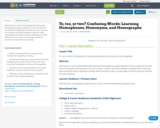
Adult learners at Low Intermediate Basic Education level (grade grouping C/grades 4-5) are introduced to words that are frequently confused such as to, too, and two. Learners use three methods to identify which confusing word should be used in speaking or writing: define the word, create a visual image, and find a synonym that has the same meaning.
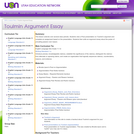
This lesson extends over several class periods. Students view a Prezi presentation on Toulmin's argument and complete an assignment based on the presentation. Students then write an argument essay about the power of prevailing passion over reason.
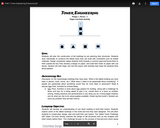
This unit consists of five lessons encouraging younger learners to engineer increasingly better towers using blocks and recycled materials. Each 30 minute lesson ("phase") includes goals, discussion, activity instructions, extensions, and student worksheets.
Phase 1: Paper Cut-Outs Activity
Phase 2: Building Blocks Activity
Phase 3: Number of Blocks Activity
Phase 4: Building within a Space Activity
Phase 5: Recycled Tower Activity
NGSS: K-2-ETS1-1, K-2-ETS1-2, K-2-ETS1-3
Common Core ELA: RI.2.1, W.2.6, W.2.8, SL.2.5
Common Core Math: MP.2, MP.4, MP.5, 2.MD.D.10

In this lesson, students will view Wendy Troxel's TEd Talk, "Why School Should Start Later for Teens." While viewing the TED Talk, students will identify and trace the main parts of her argument.
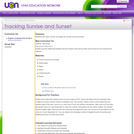
In this lesson students will collect, record, and graph the sunrise and sunset times.

This collection uses primary sources to explore the Transatlantic Slave Trade. Digital Public Library of America Primary Source Sets are designed to help students develop their critical thinking skills and draw diverse material from libraries, archives, and museums across the United States. Each set includes an overview, ten to fifteen primary sources, links to related resources, and a teaching guide. These sets were created and reviewed by the teachers on the DPLA's Education Advisory Committee.
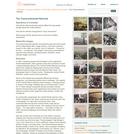
In 1862, Congress passed and President Lincoln signed the Pacific Railroad Bill, which granted public land and funds to build a transcontinental railroad. The Central Pacific Railroad would lay tracks from California heading east, and the Union Pacific Railroad would lay tracks from the Missouri River west. The photograph taken in Placer County, "Grading the Central Pacific Railroad," shows some of the construction. Work on the railroad was physically difficult and at times dangerous, and attracting workers was a challenge. The majority of the Central Pacific's laborers were Chinese. A Chinese worker is shown in the image "Heading (top cut) of East Portal, Tunnel No. 8." Both railroad companies actively recruited Chinese laborers because they were regarded as hard workers and were willing to accept a lower wage than white workers, mostly Irish immigrants. As construction progressed, the Central Pacific and the Union Pacific competed to see which could lay the most track each day. A photograph of a sign near Promontory Park, Utah, commemorates the day that Central Pacific crews laid an unprecedented 10 miles of track. The meeting of the two sets of tracks ? the "gold spike" ceremony ? took place on May 10, 1869. Several photographs and drawings depict this historic moment. Now the country was connected as never before: a journey between San Francisco and New York that previously took up to six months now took only days. The photograph "High Bridge in Loop," from Views from a Trip to California, shows a train passing quickly through a mountain pass. The transcontinental railroad allowed people to travel more, farther, and in pleasant conditions, as reflected in the photograph "Commissary Car, 'Elkhorn Club.'" The photograph "Knights of Pythias at the Santa Fe Railway Station, Anaheim" shows an example of the popularity of trains. Even as the transcontinental railroad brought the new country together, it brought change to the world of Native Americans. The tracks ran through a number of tribal territories, bringing into conflict cultures that held very different views of the land and how it might be used and lived on. The painting The First Train, by Herbert Schuyler, depicts three Indians pointing past their encampment at a train in the far distance. The railroad also brought an increasing number of European Americans west. One consequence of this influx was the depletion of the buffalo herds, a major food source for Plains Indians. European Americans would often shoot buffalo for sport from the train; by 1880, the buffalo were mostly gone and Plains Indians had been gathered onto reservations. Millions of acres of open grassland were being settled by the people moving west. Eventually, much of this land became the farmland that fed a growing nation. The transcontinental railroad opened up the West to the rest of the country, even if they never made the trip themselves. A Currier & Ives hand-colored lithograph depicts a train running along the Truckee River in Northern California. The San Francisco publishing firm of Lawrence & Houseworth hired photographers and published photographic tourist catalogs containing views of the West, which they sold commercially. The railroad took hold in popular culture, as shown by sheet music for the song "New Express Galop [sic]." There was even a railroad board game illustrating "Railroads Between New York and San Francisco, California, with Scenes on the Way."
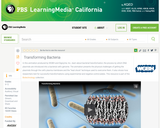
This animation produced by WGBH and Digizyme, Inc. demonstrates the experimental technique used to introduce DNA plasmids inside bacterial cells, a process called bacterial transformation.

Unit covering ethics for interpreters and translators.
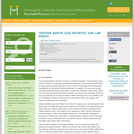
The shooting death in Sanford, Florida, of unarmed teenager Trayvon Martin at the hands of 28-year-old George Zimmerman in February 2012 has touched off debate on many issues, including the role of race in both the shooting and the subsequent investigation by the Sanford Police department.
This exercise consists of two student readings. The first reading examines the debate surrounding Florida's "Stand Your Ground" law. What is the "Stand Your Ground" law? What do supporters and critics have to say about it? What effect has it had? The second reading takes a wider look at the gun control debate. Should stronger gun control laws be passed? Questions for student discussion follow each reading.

In this lesson, students will investigate how trees change by the season. Includes discussion of techniques for identifying trees, journaling changes that take place over time for the same tree throughout the school year, a list of vocabulary, a field guid to identifying trees, and a tree journal worksheet for students.
NGSS: Partially meets 2-LS4-1
Common Core: W.2.7, W.2.8, 2.MD.D.10
Social Sciences: 3.12, 4.12
Time: 1 hour initially, then 30-40 minute lessons through the seasons
Materials: "The Seasons of Arnold's Apple Tree" book, My Tree Journal pages (included), pencils, colored pencils, and clipboards.

Students will consider what source of imagery may cause escalating threads of conversation, and consider pause strategies to avoid escalating online interactions. This lesson is part of a media unit curated at our Digital Citizenship website, "Who Am I Online?".
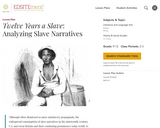
The corrupting influence of slavery on marriage and the family is a predominant theme in Solomon Northup's narrative Twelve Years a Slave. In this lesson, students are asked to identify and analyze narrative passages that provide evidence for how slavery undermined and perverted these social institutions. Northup collaborated with a white ghostwriter, David Wilson. Students will read the preface and identify and analyze statements Wilson makes to prove the narrative is true.
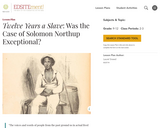
This lesson focuses on the slave narrative of Solomon Northup, a free black living in the North, who was kidnapped and sold into slavery in the Deep South. Slave narratives are autobiographies of former slaves that describe their experiences during enslavement, how they became free, and their lives in freedom. Because slave narratives treat the experience of one person, they raise questions about whether that individual's experiences exceptional.
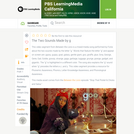
This video segment from Between the Lions is a mixed-media song performed by Fonix about the two sounds made by the letter "g." Words that feature the letter "g" and appear on screen are: gypsy, guppy, goat, galaxy, gentle giant, goo, giraffe, glue, Gina, George, Gene, Gail, Goldie, gossip, strange, gaga, garbage, luggage, grunge, grange, gadget, and gigantic. The "g" is highlighted in a different color. The song also explains the "g" sound when "g" precedes the letters e, i, and y. This video segment provides a resource for Phonemic Awareness, Phonics, Letter Knowledge Awareness, and Phonological Awareness. ***Access to Teacher's Domain content now requires free login to PBS Learning Media.
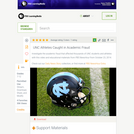
Investigate the academic fraud that affected thousands of UNC students and athletes with this video and educational materials from PBS NewsHour from October 23, 2014.
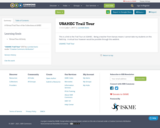
A Virtual Trail Tour of the Collections at AHEC
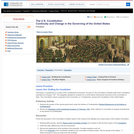
Students use Library of Congress primary sources to examine continuity and change in the governing of the United States by looking at the Constitution and linking early legislative debates to issues of...
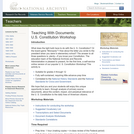
This is a self-service online workshop for teachers who use primary documents to help students see the impact and ongoing relevance of the Constitution. It requires little advance preparation and provides everything needed, including a vocabulary list, document analysis worksheets, and historical documents -- John Marshall's Supreme Court nomination (1801), proclamation to New Orleans (1803), Lincoln's telegram to Grant (1864), Johnson oath photo (1963), and more.